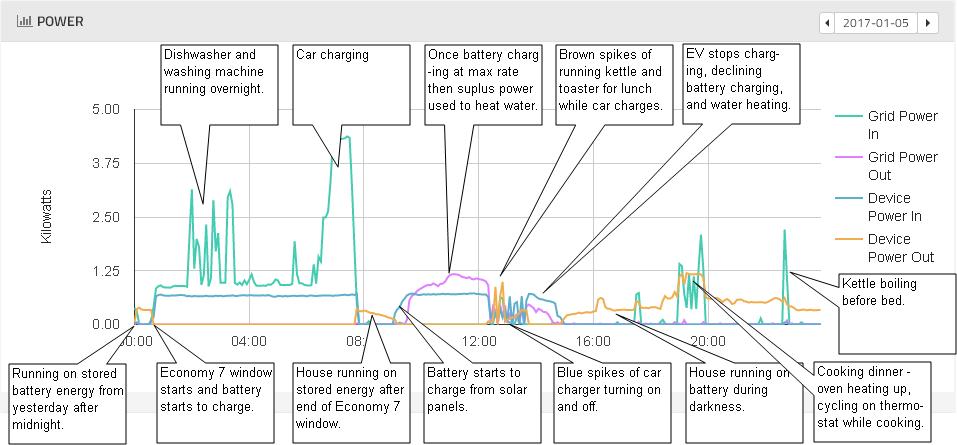January 5th was a good day to demonstrate the battery’s contribution to the home on a day on which 9.75 kWh was generated. The battery at this point in the year is configured to charge on cheap overnight electricity as well as store excess PV electricity (when there is any). The day also included evidence of water heating and car charging after I returned home at lunchtime.

Over all only 2 kWh of power was purchased during the day at full price, while 12 kWh of cheap night time electricity ran the dishwasher and washing machine, did some car charging (I charge for an hour which leaves headroom for later solar charging), and contributed 5 kWh to charging the fixed battery.
During the relatively sunny December day, as PV output rises, the battery starts to recharge and then, once the battery is charging at its maximum rate, remaining PV output is used to heat water (although described as ‘Grid Power Out’ in the chart above). At around 12:30 I arrived home and put the car on charge (the blue spikes) and made lunch (the brown spikes). The blue spikes of car charging occur as the chargers turn off intermittently to allow available power to be assessed. As PV output falls EV charging starts to require limited support from the battery (the rising brown line through the blue spikes) until eventually all EV charging stops and the system returns to a combination of battery charging and water heating.
As the sun sets the brown line rises again as the battery takes on the load of the house. Green spikes indicate boiling the kettle before 18:00, cooking dinner from shortly after 19:00, and a further kettle boil at around 23:00. Apart from these import events totalling less than 2 kWh, the house continues running on stored energy from the battery through into the next day when the cycle restarts.
At some point I assume that it will be necessary to curtail the overnight charging of the battery so that it doesn’t miss out on day time charging from PV as a result of being full. That may be responsible for some of the blue cycling with the car charging associated with the rising brown line – if the battery is already full then the car charger will be enabled at lower levels of power generation potentially causing the battery to partially support the car charging.
